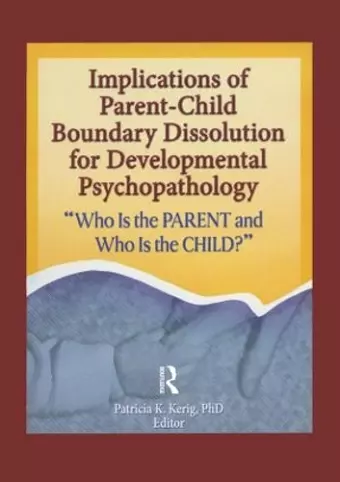Implications of Parent-Child Boundary Dissolution for Developmental Psychopathology
"Who Is the Parent and Who Is the Child?"
Format:Paperback
Publisher:Taylor & Francis Inc
Published:21st Apr '06
Currently unavailable, and unfortunately no date known when it will be back
This paperback is available in another edition too:
- Hardback£110.00(9780789030900)

Gain a better understanding of parent-child boundaries and the mechanisms for their dissolution
The breakdown of appropriate generational boundaries between parent and child can threaten the child’s psychological development. Implications of Parent-Child Boundary Dissolution for Developmental Psychopathology: Who Is the Parent and Who Is the Child? explores this covert and oftentimes ignored form of emotional abuse, discussing in detail the various ways it can manifest. This revealing text comprehensively examines how the burden of meeting the emotional needs of the parent interferes with the child’s healthy development. The boundary dissolution patterns of role reversal, enmeshment, psychological control, and triangulation are closely examined with an eye toward providing appropriate strategies for dealing with the problem.
Implications of Parent-Child Boundary Dissolution for Developmental Psychopathology is separated into four sections to focus extensively on every aspect of the problem. The first section discusses definitions, concepts, and methodological concerns of the phenomena, including a consideration of the child’s developmental responses to boundary dissolution. The second section explores the empirical research concerning boundary dissolution within the family system, and includes intriguing information on the actual mechanism that passes the pattern of role reversal on to the following generation. The next section closely examines boundary violations within high-risk families, with a focus on those undergoing divorce. The final section concentrates on cultural contexts of boundary dissolution and includes a look at the perception of familial responsibility and its effects on Bosnian youths. This one-of-a-kind resource is extensively referenced, and provides a solid foundation to inspire a new generation of theory, research, and clinical work.
Implications of Parent-Child Boundary Dissolution for Developmental Psychopathology examines:
- a multidimensional model of boundary dissolutionwith supporting research
- a comprehensive review of published literature in the areas of attachment theory, developmental capacities of the infant, child-rearing practices, and parental beliefs
- the theoretical background supporting the construct of boundary dissolution
- the boundary disturbance patterns of enmeshment and control
- the relationships between interparental conflict, parental responses to children’s emotions, and representations of role reversal and vulnerability in children’s family drawings
- the ’spill over’ effect of marital conflict
- role reversal in high-risk families
- children’s rejection of one parent over another in custody disputes
...
ISBN: 9780789030917
Dimensions: unknown
Weight: 580g
316 pages